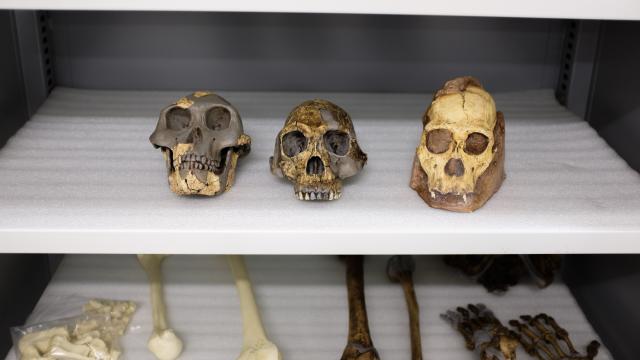Humans evolved from a group of ape-like hominins known as Australopithecine, but scientists aren’t such which species is our direct ancestor. A new statistical analysis has found it highly unlikely that one particular candidate, Australopithecus sediba, is ancestral to humans—a finding that could finally end this long-standing debate.
Most of us are familiar with Australopithecus afarensis—an ape-like hominin best exemplified by the 3-million-year-old Lucy fossil. But there’s another important species from the Australopithecine genus, one discovered just 11 years ago at the Malapa archaeological site near Johannesburg in South Africa.
This species, called Australopithecus sediba, is now known from hundreds of fossil elements dating back some 1.97 million years. These hominins featured ape-like characteristics combined with some modern, human-like features. Subsequently, its discovers, a team led by Lee Berger from the University of the Witwatersrand, argued—and continue to argue—that A. sediba is the direct, most proximate ancestral species from which the Homo genus emerged.
But there’s a problem with this hypothesis, and it has to with the timing. The fossil — a jawbone from a still-to-be identified species of early human — is 2.8 million years old. That’s 800,000 years before A. sediba. It’s thus fair to ask: How is it possible that A. sediba spawned an entirely new genus given its presence so much later than the oldest evidence of humans?
Now, it’s entirely possible a prolonged period of overlap existed during which the two hominin species co-existed. But as new research published today in Science Advances suggests, this scenario — though theoretically possible — is exceptionally unlikely. The authors of the new study, led by Andrew Du from the University of Chicago, reached this conclusion by conducting an examination of the time periods in question, creating a model to test the viability of the scenario in which humans evolved directly from A. sediba. The maths simply didn’t work out, leading the Du and his colleagues to conclude that A. afarensis is the best fit as the most proximate ancestor of Homo.
For the study, Du and his colleagues scanned the existing scientific literature looking for instances of hypothesized, co-existing ancestor-descendent relationships involving hominin species. Of the 28 examples uncovered, only one case involved a descendent older than its alleged ancestor—the Homo species H. erectus and H. antecessor. But these two hominins were separated by 100,000 years—a far cry from the 800,000 years required for the A. sediba hypothesis to work. As an important aside, the average lifespan of any hominin species is about a million years.
Willing to entertain this possibly, however, Du’s team generated a model that assumed A. sediba is ancestral to Homo.
“Given the model, we calculated the probability of finding an A. sediba fossil horizon that is at least 800,000 years younger than one from earliest Homo, which is what we observe in the fossil record,” Du wrote in an email to Gizmodo.
As the models showed, the odds of this happening were 0.9 per cent on average, which, at that level of probability, is “by definition zero,” the authors write in the study. This degree of probability is very low, and “because A. sediba does postdate earliest Homo by 800,000 years in reality, this suggests our model’s assumption — A. sediba being ancestral to Homo—is incorrect and can be falsified,” said Du, who added: “This is a common way to rigorously falsify and refute hypotheses.”
A. afarensis, on the other hand, existed much closer in terms of time and space to the aforementioned jaw. The Lucy fossil, along with the remains of an A. afarensis child found in 2000, were located just a few miles from the human jaw in Ethiopia. Also, the physical features of the human jaw are more consistent with those seen on A. afarensis.
“Given the timing, geography and morphology, these three pieces of evidence make us think afarensisis a better candidate than sediba,” Zeray Alemseged, a paleontologist at the University of Chicago and a co-author of the new study, said in a statement. “One can disagree about morphology and the different features of a fossil, but the level of confidence we can put in the mathematical and statistical analyses of the chronological data in this paper makes our argument a very strong one.”
Importantly, the researchers aren’t saying A. afarensis is the most direct human ancestor—it’s just the current best fit given the available fossil evidence.
“This is probability statistics at its best,” said Yohannes Haile-Selassie, a physical anthropologist from the Cleveland Museum of Natural History, in an email to Gizmodo. “I had no doubt in my mind—nor did many in our field—that A. sediba could not have been the ancestor of Homo, not only because the earliest known representative of Homo is 800,000 years older, but also because A. sediba does not have all of the morphological features that one would expect to see from the earliest Homo,” said Haile-Selassie, who wasn’t involved with the new research.
“I hope Du and Alemseged’s work lays this issue to rest,” he wrote. “We still have to look for the ancestor of the genus Homo even though A. afarensis appears to be the best candidate for now. Let’s keep looking, the fossil record is always full of surprises!”
Fred Spoor, a professor at the Centre for Human Evolution Research (CHER) at the Natural History Museum in London who’s not affiliated with the new research, said the paper is important because “it statistically tests unsubstantiated headline claims” made about A. sediba.
“It’s good to see that detailed statistical analyses confirm what always seemed common sense; that it is really rather unlikely that Australopithecus sediba was directly ancestral to the genus Homo,” Spoor told Gizmodo in an email.
Though the origins of the Homo genus may still be murky, scientists are fairly confident about when and where Homo sapiens, our own distinct species, first arose: about 300,000 years ago in northwest Africa.
